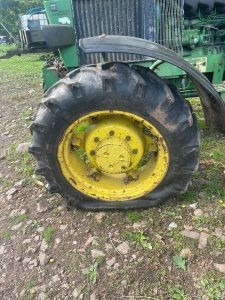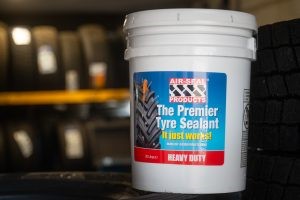If you have ever been stranded by a flat tyre on your ATV ten miles away or suffered a puncture on your combine in the middle of harvest?
Then you know the importance of a good tyre sealant. Air-Seal Products discusses the key characteristics of a high-performance tyre sealant to help you avoid being stranded by an inopportune puncture, regardless of whether your tyres are tubed, tubeless, high-speed, low-speed, on-road, off-road, or even water-ballasted.

How does a tyre sealant work?
The key word is ‘preventative’. The tyre sealant should be installed into the tyre as early in its life as possible so punctures can be sealed the instant they occur.
A modern tyre sealant is a suspension of synthetic fibres and fillers in a thickened ethylene or propylene glycol (anti-freeze) and water “carrier system”, which allows the fibres and fillers to move within the tyre in liquid form.
When a puncture occurs, the air loss in the tyre propels the suspended fibres and fillers into the puncture site where the fibres snag on the rubber. These fibres tangle in the wound which stops air from escaping.
As the tyre rotates, the flexing of the rubber packs more fibres into the hole until no more will fit. The fillers (extremely small particles) will then pack in between the fibres to form a permanent airtight seal that will last the life of the tyre.
Performance Characteristics
- 1) Fibres – The fibres constitute the backbone of the tyre sealant, the stronger the fibres, the stronger the repair. Air-Seal Products claims to use some of the strongest, abrasion-resistant synthetic aramid fibres, which were specifically chosen to ensure punctures are sealed for the life of the tyre.
- 2) Fillers – Once a strong plug has been formed by the fibres, the filler particles provide the final seal by lodging in between the fibres and forming an effective, air-tight seal.
- 3) Suspension Stability – The only purpose of the liquid portion of the sealant formulation is to carry the fibres and fillers to the site of the puncture. However, if a sealant separates then it will not perform effectively! Beware of sealants that show signs of separation in a container or require shaking or mixing before use!
- 4) Freeze Protection – Most tyre sealant users in this country will experience below-freezing temperatures at least a few times per year. Be sure that your sealant is freeze protected to prevent the possibility of a horrendous vibration caused by a lump of ice in your tyres.
- 5) Inertness – This means the sealant will not react chemically with any part of the tyre/wheel assembly, which is critical to maintaining the manufactures warranty on both! Any sealant that works by “curing” or “reacting with air” should be avoided.
- 6) Corrosion Protection – Most tyre sealants contain water, and we all know what happens to metal after prolonged exposure. The same technology used to prevent corrosion and rust in water cooling system works in sealants. Ensure that your sealant contains corrosion inhibitors before you put it into those tyre and wheel assemblies that could cost hundreds to replace!

What else can tyre sealants do?
The most dramatic benefit of a high-performance tyre sealant is the prevention of flat tyres from punctures. Additional benefits you could experience with the right sealant include the prevention of slow air leaks which stops under-inflation of tyres, increases fuel efficiency by up to 3%, and increases tyre life by up to 20%.
This will also reduce the risk of catastrophic failures such as blowouts (on-road) or ‘bead roll-offs’ (off-road). The financial savings associated with the use of a good tyre sealant can be overshadowed by the safety benefits!
For more information go to www.air-sealproducts.com

